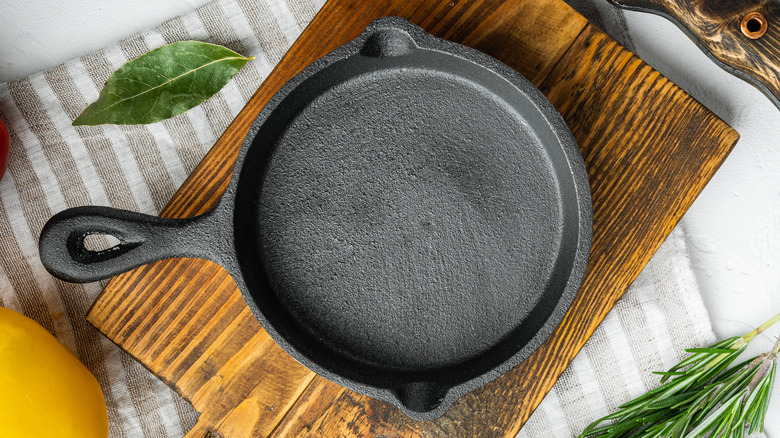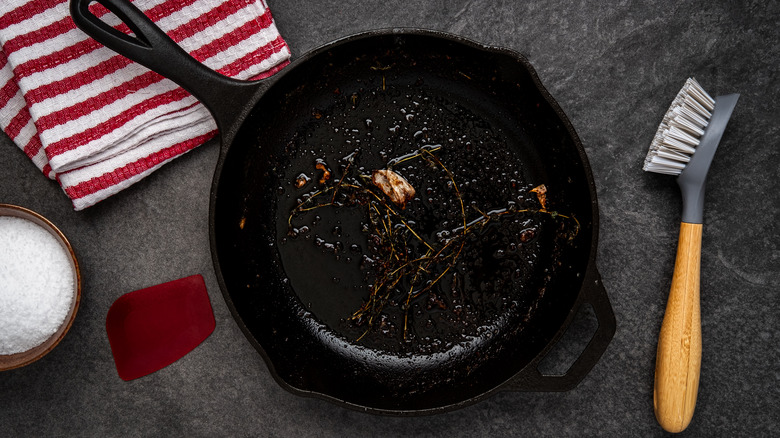Michael Symon's Top Tip For Cleaning A Cast Iron Pan
Cast iron skillets are coveted kitchen tools that have been used for millennia. It's believed that cast iron cookware has been around as early as China's Han Dynasty around 220 AD and resurged in popularity in Europe during the 16th century, per WebstaurantStore. And as Eater notes, the metal was "one of the most important materials in China for the next 1,000 years, where it was used mostly to forge weapons and tools for farming and agriculture." Today, cast iron is making a massive comeback thanks to its esteemed durability, longevity, and sustainability. These heavy duty pans can be used to prepare all sorts of meals, including breads, pastas, stews, desserts, meats, breakfast dishes, and much more, per Taste of Home. You can even use them to help speed up the defrosting process (via America's Test Kitchen).
Cast iron is a well-loved, deeply trusted material that can last for many years, although it requires plenty of care to maintain the very best quality. A lot of this comes down to how it's cleaned between uses. There are also a few important guidelines when it comes to how not to clean your cast iron. For example, thou shall never place your cast iron in the dishwasher nor scrub it with harsh detergents, according to Lodge, one of the world's best-selling cast iron brands. Doing so can cause rusting and long-term irreversible damage. So, how do the pros recommend protecting this tried-and-true culinary staple? Chef Michael Symon offers a simple method he swears by.
Chef Symon's go-to cast iron cleaning tip requires a pantry staple
There are several acclaimed ways to effectively clean cast iron skillets, but the one chef Michael Symon prefers can be found near your spice rack. Let's say you've whipped up a hearty meal in your cast iron skillet, leaving behind a fussy layer of "gunk," as chef Symon calls it in a video shared on Food Network's Twitter page. To properly clean it, the award-winning restaurateur first suggests using a dry paper towel to wipe up as much debris as possible. Next, place your pan on the stove and carefully turn the burner on high heat. As the skillet warms up, shake a generous amount of kosher salt onto the surface, making sure to coat the entire bottom.
Allow the salt to heat up for a minute or two, as this will activate its antimicrobial properties and help absorb any excess fat molecules, chef Symon explains. When the salted pan is nice and hot, use a grungy (yet laundered) towel to thoroughly rub the salt around. (To prevent accidental burns, make sure you're wearing an oven mitt or have another thick towel in your other hand for this part!) After a short while, you'll notice the salt turning a slightly darker color, which is caused by the absorption of the icky substances. Keep scrubbing until the surface is free of scraps. When the cast iron is all clean, turn off the heat and discard the salt. Voila!
There are many other practical ways to clean cast iron
While Chef Michael Symon's cast iron cleaning method is passably foolproof, there are other proven techniques used by home and professional cooks alike. Thankfully, you won't need any fancy tools or expensive products to accomplish this feat, no matter which strategy you opt for. For instance, recipe developer and cookbook author Emily Han suggests vigorously using a scrub brush or sponge plus some vegetable oil or shortening to safely remove leftover food remnants and season the pan. She highly recommends cleaning your skillet while it's still hot — and remember, never let it soak in the sink! This will cause the iron to rust.
Other pros have their own favorite cast iron skillet cleaning routines. Controversial chef Brad Leone, who frequently collaborates with Bon Appétit to demonstrate various culinary tips on social media, has a quick and easy way to make cast iron look pristine and prepped for your next dish. Leone's method involves a scrubbing pad, water, an oven, and similarly to Chef Symon's method, some coarse kosher salt. Then, to season the skillet, grab a neutral oil with a high smoke point such as vegetable, grapeseed, or flaxseed. Sprinkle a bit of oil into the base of the pan and, with a few paper towels or a dish rag, carefully rub the oil around the entire surface — sides and bottom included. Once you've prettied up your pan and you're ready to get cooking, there are many ways to use your cast iron skillet.


